Film Advance Mode There are four (4) automatic film advance modes
in the Nikon F5. To choose a mode, rotate the film advance mode/self-time( selector
while pressing the film advance mode selector lock release. Set S for Single-frame
shooting, CL for Continuous low-speed shooting, CH
for Continuous high-speed shooting or Cs for Continuous silent-low-speed shooting,
Single-Frame Shooting With the film advance mode
at S, fully depressing the shutter release button takes one picture and automatically
advances the film by one frame. Film advances immediately after the shutter closes
whether you remove your finger from the shutter release button or keep the button
depressed.
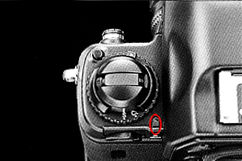 |
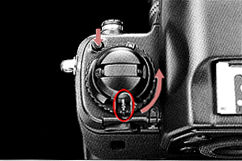 |
To take the the next shot, lift your finger from the button, then fully depress It again. Use Single-frame shooting for stationary subjects or subjects that do not require several frames of rapid firing. |
Continuous Shooting Shoots are taken continuously as long as you keep the shutter release button fully depressed. You have a choice of shooting speeds up to approx. 7.4 fps (frames per second) in CH mode,up to approx. 3 fps in CL mode and approx. 1 fps in Cs mode with fresh AA-type alkaline or lithium batteries at normal temperature 20 degrees C or 68 degrees F) and a shutter speed of 1/250 sec. or higher In Manual exposure and Continuous Servo AF modes. With shutter speeds slower than 1/250 sec., the framing rate becomes progressively slower in proportion to the shutter speed(s) In use.
 |
 |
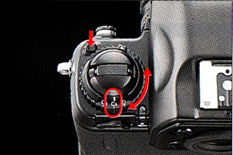 |
Note: Film advance speed using fully charged optional rechargeable Ni-MH Battery Unit MN-30 is up to approx. 8 fps in CH mode, up to approx. 3 fps in CL mode and approx. 1 fps in Cs mode. |
In CH and CL modes, the shooting speeds can be changed using Custom Setting #9. |
Focus Area: Selecting Focus Area Five focus areas are available with the F5. To select your desired focus area, press top, button, left or right on the focus area selector. Corresponding focus areas appear in the viewfinder and top LCD panel. Arrows or top (
 |
|
Note: When Spot Metering is selected, shifting the focus area also shifts the Spot Metering area accordingly. |

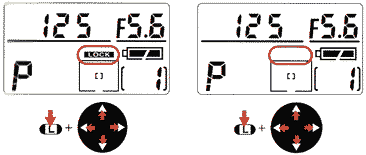 |
|
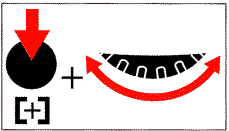 |
Selecting AF Area Mode While pressing AF area mode ( |
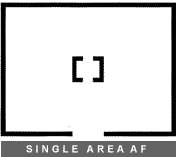 |
When Single Area AF mode is selected, you may designate the focus area you wish to use, and that choice will remain unchanged regardless of subject movement. |
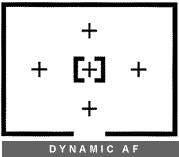 |
When Dynamic AF mode is selected, |
NOTE: Viewfinder indication DOES NOT change even though the sensor is shifted in the Dynamic AF mode,
Focus Mode The Nikon F5 has two autofocus modes, Single Servo AF with Focus Priority and Continuous Servo AF with Release-Priority. Note: In either of these modes - and in any film advance mode -Focus Tracking automatically activates when the subject starts moving - provided you are NOT using Single Servo AF mode and the focus has already locked, OR in the case when you are using Continuous Servo AF, and are pressing the AE-L/AF-L button.
Caution: Do not attempt to turn the lens focusing ring or impede its rotation when the focus mode selector is set to Single Servo AF (S) or Continuous Servo AF (C).
Release-Priority can be given to Single-Servo AF OR Focus Priority to Continuous Servo AF using the Custom Setting #1. |
Single Servo AF with Focus-Priority For Single Servo AF, set the focus mode to "S". Lightly press the shutter release button to activate focus adjustment. Because the priority is on correct focus, the shutter cannot be released until the subject is in focus. After focus is achieved with a stationary subject, the focus remains locked for as long as the shutter release button is lightly pressed. Focus locks with any one of the five focus areas selected (in Single Area AF mode). If the camera-to-subject distance changes however, you must refocus by lifting your finger from the shutter release button momentarily, then lightly pressing the button again.
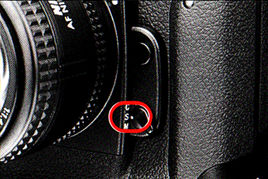 |
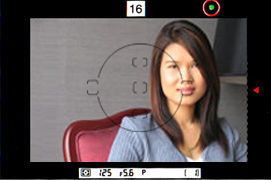 |
With a stationary subject: Lightly press shutter release button. When the subject is in focus, the lens stops moving, the in focus indicator |
Shooting a Moving Subject:
Lightly press shutter release button to automatically activate Focus Tracking. Confirm
![]() appears
in the viewfinder then fully depress the shutter release button. (The shutter release
button can in fact be depressed without confirming
appears
in the viewfinder then fully depress the shutter release button. (The shutter release
button can in fact be depressed without confirming ![]() Indication; as soon as the subject comes into
focus, the shutter will be released). Focus Tracking remains activated as long as
you keep the shutter release button lightly pressed. If the subject stops and
Indication; as soon as the subject comes into
focus, the shutter will be released). Focus Tracking remains activated as long as
you keep the shutter release button lightly pressed. If the subject stops and ![]() appears,
focus is locked. If subject moves again, remove your finger from the shutter release
button and lightly press it again to start autofocus with Focus Tracking.
appears,
focus is locked. If subject moves again, remove your finger from the shutter release
button and lightly press it again to start autofocus with Focus Tracking.
Note: Single
Servo AF is convenient for off-center subjects. After shooting with the film advance
mode selector set at "S", you do not have to remove your finger
from the shutter release button to take the next shot. Slightly lift your finger
from the button (while maintaining the button in the half-depressed position) then
fully depress it to release the shutter again. The focus setting will remain unchanged
from the prior setting. In Single Servo AF with Focus-Priority mode, the focus remains
locked even after the shutter is released, unless you remove your finger from the
shutter release button. With the film advance mode set at CL,
CH or Cs, the camera refocuses every time the
shutter is released.
| If |
and display in viewfinder when operates in the Autofocus mode can be canceled by using Custom Setting #23. |
Continuous Servo AF with Release-Priority Set focus mode to "C" for Continuous Servo AF. In Continuous Servo autofocus mode, as you lightly press the shutter release button, focus detection begins and the Ions continues to focus for as long as you keep the shutter release button [lightly pressed. Since the priority is on shutter release, you can fully depress the shutter release button regardless of focus status. Wherever the subject distance charges due to movement of the subject in Continuous Servo AF mode, the F5 will refocus on the subject at the new distance.
 |
 |
Lightly press shutter release button to start autofocus operation. When the subject is in focus, the camera's autofocus motor (or the built-in motor of an AF-S or AF-I Nikkor lense) stops driving the autofocus lens and |
NOTE: As focus is NOT loaded in Continuous Servo AF, to handle off center subject, you may use the AE-L/AF-L button and recompose the picture.
| If |
Manual Focus:
To focus manually when using Nikon lenses that do not have an A/M switch, set the
camera's focus mode selector to M. When using a Nikon lens that has an A/M
switch. set the lens' switch to M; when using an AF-S or AF-I Nikkor lens,
set the switch to M or M/A; with these lens types it is not necessary to change
the camera's focus mode selector. There are two ways of assuring precise manual focus-with
the Electronic Rangefinder or with the viewfinder's clear matte field.
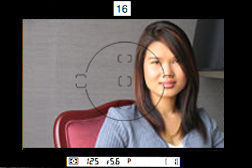 |
Manual focus with Electronic Rangefinder The Electronic Rangefinder provides you with viewfinder indications that show the focus status while you are focusing. It works with most Nikon lenses (including AF Nikkor when operated manually) having a maximum aperture of f/5.6 or faster. (For a complete list of usable lenses, see Lens Compatibility Section for more info). |
1. Look through viewfinder and position the selected focus bracket on main subject. Then lightly press shutter release button. You may select any one of the focus brackets 2. While lightly pressing shutter release button, rotate lens focusing ring in the direction indicated by the focus-to-left arrow (
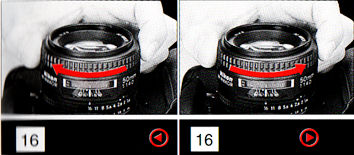 |
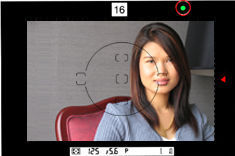 |
 |
3. Confirm in-focus indicator ![]() appears,
then fully depress shutter release button to take the picture. For special focusing
situations
appears,
then fully depress shutter release button to take the picture. For special focusing
situations ![]() blinks to Indicate that the Electronic Rangefinder
does not work correctly. Focus with clear matte field instead.
blinks to Indicate that the Electronic Rangefinder
does not work correctly. Focus with clear matte field instead.
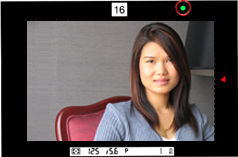 |
Manual Focus using Clear Matte field: Look through viewfinder and rotate lens focusing ring until image on the matte filed appears sharp. |
| previous | NEXT | 4/18 Metering Setup and Exposure Indications
| Back to Index Page |
Instruction Manual for Nikon F5
|
Back | Main Index Page - Nikon F5
Professional SLR camera
The Camera - Background,
Issues & Summary
Basic
Features | Focusing | Metering Systems | Exposure Control | Reliability Issues | Nikkor lens Compatibility
Prisms/Finders - Index page
- 2 parts
Film Backs: Index
Page - 1 parts
Focusing Screens - Index
Page - 1 part
Flash System - Index
Page
- 3 parts
System Accessories: | Power Sources | Cases | Remote
Control | Miscellaneous
Macro
Photography
- Related info on Micro-Nikkor lenses
Technical Specification for Nikon F5
Main
Reference Map
/ Nomenclature
Resource Centre:
Instruction Manuals
Nikon
F5 Camera Body
- 18
parts
MF-28
Multi-Function Back
HTML - 8
parts
PC
Links - Photo Secretary
- 2
parts
AF-TTL Speedlights:
SB-28 / SB28DX | SB29(s) info | SB30 | SB50DX | SB80DX | SB600 info | SB800
Variants: F5 50th Anniversary Model | Nikon/Kodak DCS-620 | DCS-720 Digital Still SLR camera
| Nikon F | Nikon F2 | Nikon F3 | Nikon F4 | Nikon F5 | Nikon F6 | Nikkormat / Nikomat | Nikon FM | Nikon FE/ FA | Nikon EM/FG/FG20 | Nikon Digital SLRs | Nikon - Other models |
The Eyes of Nikon:-
Nikon Auto Focus Nikkor lenses:- Main
Index Page
Nikon Manual Focus Nikkor lenses:- Fisheye-Nikkor Lenses - Circular | Full Frame |
Ultrawides Lenses - 13mm15mm18mm20mm | Wideangle Lenses - 24mm28mm35mm | Standard Lenses - 45mm 50mm 58mm | Telephoto
Lenses - 85mm105mm135mm180mm & 200mm | Super-Telephoto Lenses - 300mm 400mm 500mm 600mm 800mm 1200mm |
 Index Page |
Special
Application lenses: Micro-Nikkor Lenses - 50mm~55mm -60mm 85mm -105mm 200mm Micro-Zoom 70-180mm Perspective Control (PC) - 28mm 35mm PC-Micro 85mm Dedicated Lenses for Nikon F3AF: AF 80mm f/2.8 | AF 200mm f/3.5 EDIF Depth of Field Control (DC): 105mm 135mm Medical Nikkor: 120mm 200mm Reflex-Nikkor Lenses - 500mm 1000mm 2000mm Others: Noct Nikkor | OP-Nikkor | UV Nikkor 55mm 105mm | Focusing Units | Bellows-Nikkor 105mm 135mm Nikon Series E Lenses: 28mm35mm50mm100mm135mm | E-Series Zoom lenses: 36~72mm75~150mm70~210mm |
MF Zoom-Nikkor Lenses: 25~50mm | 28~45mm | 28~50mm | 28~85mm | 35~70mm | 36~72mm E | 35~85mm | 35~105mm | 35~135mm | 35~200mm | 43~86mm | 50~135mm | 50~300mm | 70~210mm E | 75~150mm E | 80~200mm | 85~250mm | 100~300mm | 180~600mm | 200~400mm | 200~600mm | 360~1200mm | 1200~1700mm
Tele-Converters: TC-1 | TC-2 | TC-200 | TC-201 | TC-300 | TC-301 | TC-14 | TC-14A | TC-14B | TC-14C | TC-14E | TC-16 | TC-16A | TC-20E
Recommended links to understand more technical details
related to the Nikkor F-mount and production Serial Number:
http://rick_oleson.tripod.com/index-153.html by: my
friend, Rick Oleson
http://www.zi.ku.dk/personal/lhhansen/photo/fmount.htm by: Hansen,
Lars Holst
http://www.mir.com.my/rb/photography/hardwares/nikonfmount/lens2.htm
http://www.photosynthesis.co.nz/nikon/serialno.html
| Back | Index Page of Digital
Nikon SLR cameras
|
Back | Main Index Page of Pictorial
History of Nikon SLR cameras
![]()
 |
| Message Board | for Nikon F5 Series SLR model(s) | |
HOME - Photography in Malaysia |
![]()
A resource dedicated to my kids, Alvin Foo & Esther Foo- one day,
BOTH might need to use all these information for his/her Nikon F5A camera.
Volunteered Maintainer(s) for the Nikon F5 Message Board: Tony Davies-Patrick, UK; Rick Oleson, US; Koh Kho King, Malaysia.
Credit: Mr. Chuck Hester, US for his text re-editing skill for this site; Our staff, HowKiat® who created the 3D-Nikon F5 logo. Mr. Lew Chee Wai of YL camera for lending his F5 for me to take some shots appeared in this site. All those nice folks who have contributed their images, in particular Mr. Mike Long, Edwin leong, Palmi Einarsson, Sergio Pessolano, Fred Kamphues, Harry Eggens, Curtis Forrester, Nick (Natures Moments), Sandra Bartocha; fellow countrymen, Vincent Thian, Koh Kho King, Philip Chong, CY Leow etc. and contributions from a few nice folks from Photo Malaysia Forum. Disclaimers & acknowledgments: Certain content and images appeared in this site were either scanned from official marketing leaflets, brochures published by Nikon and/or contribution from surfers who claimed originality of their own work for public publishing in this website, where majority of the extracted information are used basing on educational merits. The creator of this site will not be responsible for any discrepancies that may arise from any possible dispute except rectifying them after verification from respective source. Neither Nikon or its associates has granted any permission(s) in using their public information nor has any interest in the creation of this site. "Nikon", "Nikkormat", "Nippon Kokagu KK" "Silent Wave", "Focus Tracking Lock-on", "Nikkor" & other applicable technical/business terms are registered trade name(s) of Nikon Corporation Inc., Japan. Site made with an Apple G5 IMac.
